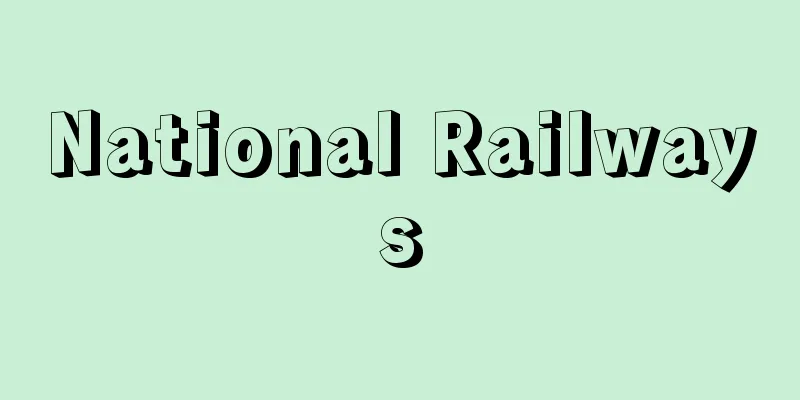National Railways

|
Generally, railways are owned and managed by the state. There are various types of business structures, such as direct government management and management by special corporations funded by the government. European railways, which were established as privately owned and operated, were increasingly nationalized from the end of the 19th century to the 20th century. Japan was established as a publicly operated railway from the beginning, and in 1869 (Meiji 2), it decided to build a trunk line between Tokyo and Kobe. In 1872, it opened between Shinbashi and Yokohama, and in 1874, between Osaka and Kobe, but construction of the trunk line stagnated due to a lack of funds, and in 1881, the Japan Railway Company was established and construction by private railways began. From this time on, publicly established and operated railways came to be called government railways, and privately established and operated railways came to be called private railways. In 1889, the Shinbashi-Kobe section was fully opened, and in that year the number of kilometers of private railways in operation surpassed that of government railways. The government-run railways implemented a special accounting system in 1890, and the promulgation of the Railway Construction Act in 1892 established government leadership in railway construction, and the enactment of the Railway Business Act, Private Railway Act and other laws in 1900 (Meiji 33) promoted the standardization of operations and facilities of public and private railways. Nationalization of major private railways had been advocated since the 1890s, but after the government's establishment of leadership as described above, it became concrete during the Russo-Japanese War, and as part of the establishment of measures to strengthen the economic and military systems after the Russo-Japanese War, the Railway Nationalization Act was promulgated in 1906, and by the following year 17 major private railways had been nationalized. From this time on, the name of the government-run railway was changed to National Railways (JNR), and the development and improvement of trunk lines and connecting sea routes progressed. In 1920 (Taisho 9), the Ministry of Railways was established, and trunk line improvements and electrification, as well as the construction of local lines, survived the Great Depression with technological advances and outstanding business policies. However, the railway suffered great damage from wartime transport and war damage during World War II, and in 1949 (Showa 24) under the postwar occupation regime, it was forced to transition to a public corporation, the Japan National Railways. Under this regime, the JNR achieved a number of things, starting with the replacement of aging facilities, modernization of power sources, improvements to trunk line transport such as express trains and Shinkansen, and an increase in commuter transport capacity. However, restrictions on the parties' ability to manage independently, worsening labor issues, and the advancement of automobiles, ships, and aircraft led to a decline in the ratio of JNR to total transport volume, and in fiscal 1984, passenger transport accounted for approximately 23% and freight transport accounted for approximately 5%, with an annual operating loss of 1.8193 trillion yen and an accumulated deficit of approximately 20 trillion yen, resulting in a state of financial collapse. In the 1970s, several financial reconstruction measures were implemented, and from fiscal 1981, a five-year financial reconstruction plan was implemented, but none of them were successful, and the company was divided and privatized in April 1987. As a result, the company was divided into six passenger railway companies, one freight railway company, and the Shinkansen Railway Holding Corporation, collectively known as JR. [Harada Katsumasa] National Railways of the WorldIn developed capitalist countries, it is rather the exception for a state to own and operate railways; in the UK, France, the US and other countries, railways all developed as privately managed railways. In these countries, the development of automobiles had broken down the railway monopoly even before World War II, and with the exception of the US, railway facilities had been severely devastated by the war, making it difficult to reconstruct railways, which play an important role as a driving force for industry, as privately managed railways. For this reason, in the UK, under the Labour government, the Transport Act of 1947 was enacted, and railways and their ancillary businesses, the London Passenger Transport Board and others were nationalized in 1948. From 1963, they were operated as British Rail (BR) on an independent accounting basis. However, in 1993, they were privatized again under the Conservative government. In France, the national railway company, Société Nationale des Chemins de fer Français (SNCF), a mixed public-private company (51% of capital was state-owned, 49% private), was established in 1938. Thereafter, the private capital was gradually depreciated, and in 1983 the company was re-launched as a national railway in both name and reality. America is a country with a strong tradition of a liberal economy, but in 1970, America's largest railroad company, Penn Central Railroad, went bankrupt, which had a serious impact on related industries. As a result, Amtrak (National Railroad Passenger Service) was established in 1971, and intercity passenger transport was nationalized. For freight transport, the Consolidated Railroad Company (abbreviated as Conrail) was established in 1976, focusing on the Northeast and Midwest. Conrail was also operated under the supervision of the federal government, but in 1997 it was split up and acquired by CSX and Norfolk Southern Railroad, both based in the east. In Germany, the German National Railway was established in 1920 under the Weimar Constitution. The management structure was subsequently restructured due to the payment of large amounts of war reparations. After the division and occupation of the country after the Second World War, the German Federal Railway Deutsche Bundesbahn (DB) was established in the former West Germany in 1951, and the German National Railway Deutsche Reichsbahn (DR) was established in the former East Germany. However, with the unification of Germany in 1990, they were unified into the German Railway Deutsche Bahn (DB). [Oshima Totaro and Harada Katsumasa] "Oshima Totaro Collected Works 1: The Historical Development of National Railways" (1982, Tokishiosha)" ▽ "Amemiya Yoshinao, "Nationalization and the Current Situation in the History of Railways in Foreign Countries" (included in Jurist Special Issue General Feature 31: National Railways, 1983, Yuhikaku)" ▽ "Nakanishi Kenichi, National Railways" (1987, Koyoshobo)" ▽ "Japan National Railways (ed.), 100 Years of the Japan National Railways, 19 Volumes, Reprint Edition (1997, Seizando Shoten)" [References] | | | | |Source: Shogakukan Encyclopedia Nipponica About Encyclopedia Nipponica Information | Legend |
|
一般には国家の所有・管轄下に置かれる鉄道。企業形態としては、政府直営、政府出資の特殊法人による経営などさまざまな形態がある。民有・民営方式で創業したヨーロッパ各国の鉄道は、19世紀末から20世紀にかけて国有化するものが増加した。日本では創業当初から官設・官営の方式をとり、1869年(明治2)に東京―神戸間の幹線建設の方針を決定した。72年には新橋―横浜間、74年には大阪―神戸間を開業したが、資金の不足から幹線建設は停滞し、81年日本鉄道会社が設立され、民営鉄道による建設が開始された。このころから官設・官営の鉄道は官設鉄道、民設・民営の鉄道は私設鉄道(私鉄)とよばれるようになった。89年には新橋―神戸間が全通したが、この年私設鉄道の営業キロ数は官設鉄道のそれを凌駕(りょうが)した。官設鉄道は90年に特別会計制度を実施、92年の鉄道敷設法公布によって鉄道建設についての政府の主導権を確立、1900年(明治33)の鉄道営業法、私設鉄道法その他の法規により、官・私鉄道の営業、施設にわたる規格化を推進した。主要私設鉄道の国有化は1890年代から唱えられたが、以上のような政府の主導権確立を経て、日露戦争中から具体化し、日露戦争後の経済・軍事体制強化方策確立の一環として、1906年に鉄道国有法が公布され、翌年までに主要私鉄17社が国有化された。 このときから官設鉄道の呼称は国有鉄道(国鉄)と改められ、幹線網、連絡航路の整備・改良が進んだ。1920年(大正9)鉄道省が設置され、幹線改良・電化、地方線の建設が進み、技術の進歩と卓抜した営業方針で世界恐慌を乗り切った。しかし、第二次世界大戦の戦時輸送と戦災で大きい被害を受け、戦後の占領体制の下で、49年(昭和24)公共企業体日本国有鉄道への移行が強制された。国有鉄道はこの体制によって老朽施設の取り替えに始まり、動力近代化をはじめ、特急・新幹線などの幹線輸送の改善、通勤輸送力の増強などを実現した。しかし、自主的な経営における当事者能力に対する制約、労働問題の深刻化に加えて、自動車、船舶、航空機の進出などにより全輸送量に対する比率は低下、84年度には旅客は約23%、貨物は約5%となり、年間経営損失1兆8193億円、累積赤字約20兆円と財政は破綻(はたん)状態となった。1970年代には数回にわたる財政再建措置、81年度からは財政再建五か年計画が行われたが、いずれも成功せず、87年4月、企業分割・民営化が実施された。その結果、全国で六つの旅客鉄道会社と一つの貨物鉄道会社および新幹線鉄道保有機構に分割、JRと総称されることとなった。 [原田勝正] 世界の国有鉄道先進資本主義国において、鉄道を国が所有し経営することはむしろ例外であって、イギリス、フランス、アメリカなどいずれも民営鉄道として発達した。これらの国では、第二次世界大戦前から自動車の発達により鉄道の独占は崩れ、さらにアメリカを除いて戦争による施設の荒廃が激しく、産業の原動力として重要な役割を果たす鉄道を、民間経営として再建することは困難であった。このためイギリスでは、労働党政権の下で1947年公布の運輸法により、鉄道とその付帯事業、ロンドン旅客運輸公社などが48年から国有化された。63年からはイギリス鉄道公社British Rail(BR)として独立採算制で運営された。しかし93年に保守党政権下でふたたび民営化された。 フランスでは、1938年に公私混合会社(資本の51%は国、49%は民間)であるフランス国有鉄道会社Société Nationale des Chemins de fer Français(SNCF)が設立され、その後しだいに民間資本は償却され、83年から名実ともに国有鉄道として再発足した。 アメリカは自由主義経済の伝統の強い国であるが、1970年アメリカ最大の鉄道会社ペン・セントラル鉄道が倒産し、関係業界に深刻な影響を与えた。このため71年にアムトラックAmtrak(全米鉄道旅客輸送公社)が設立され、都市間の旅客輸送は国有化された。貨物輸送については76年、北東・中西部を中心にコンソリデーテッド鉄道会社(略称コンレールConrail)が設立された。コンレールも連邦政府の監督の下に経営されたが、97年に東部を地盤とするCSXとノーフォーク・サザン鉄道に分割買収された。 ドイツではワイマール憲法の下で1920年ドイツ国有鉄道が設立された。その後多額の戦争賠償金支払いのため、経営形態は再編成された。第二次世界大戦後の分割占領により旧西ドイツでは51年にドイツ連邦鉄道Deutsche Bundesbahn(DB)が、旧東ドイツではドイツ国有鉄道Deutsche Reichsbahn(DR)が発足した。しかし1990年のドイツ統一に伴い、ドイツ鉄道Deutsche Bahn(DB)に統一された。 [大島藤太郎・原田勝正] 『『大島藤太郎著作集1 国有鉄道の史的発展』(1982・時潮社)』▽『雨宮義直「諸外国の鉄道史にみる国有化と現状」(『ジュリスト増刊総合特集31 国鉄』所収・1983・有斐閣)』▽『中西健一著『国有鉄道』(1987・晃洋書房)』▽『日本国有鉄道編『日本国有鉄道百年史』全19巻・復刻版(1997・成山堂書店)』 [参照項目] | | | | |出典 小学館 日本大百科全書(ニッポニカ)日本大百科全書(ニッポニカ)について 情報 | 凡例 |
<<: National forest - kokuyuurin
Recommend
Ecology Movement - Ecology Movement
Ecology is an English word that means ecology, a b...
Catacombs - catacumba (Latin)
Catacombs of ancient Christians. From the Greek k...
Cirsium nipponicum
…[Hiroshi Aramata]. … *Some of the terminology th...
Haemanthus multiflorus (English spelling) Haemanthusmultiflorus
…[Tora Saburo Kawabata]. … *Some of the terminolo...
Production cost - production cost
The total price paid for production factors such a...
Kyobashi - Kyobashi
[1] A bridge over the Kyobashi River in Chuo Ward,...
Eggnog (English spelling)
A soft drink made by thoroughly mixing eggs, milk,...
Hines, Gregory
Born: February 14, 1946 in New York, New York [Die...
Chilpancingo (English spelling)
Its official name is Chilpancingo de los Bravos. I...
réalisme poétique (English)
...He was from a film family: actor Pierre R. (18...
Rostrhamus sociabilis (English spelling) Rostrhamussociabilis
…Both species have a dark brown appearance, but m...
Sand collar
...This is called a sand collar (illustration), a...
Peanut oil - peanut oil
An oil obtained by pressing peanut seeds (beans) u...
Kama (river)
The Volga is the longest tributary on the left ban...
Side dance - gawaodori
...In the Edo period, the idea of amazed people...


![Kaida [village] - Kaida](/upload/images/67cb293f382af.webp)






